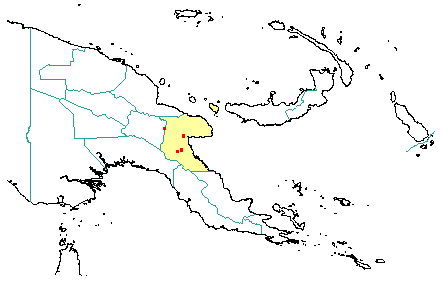
in PNGplants database
PNGTreesKey – Heritiera trifoliolata (F.Muell.) Kosterm. |
Barry Conn (NSW) & Kipiro Damas (LAE).
Guide to trees of Papua New Guinea
Copyright held by the authors, National Herbarium of New South Wales, and Papua New Guinea National Herbarium
Monograph of the Genus Heritiera 65 (1959)
Other Literature: Kosterman, Reinwardtia 528 (1959)
Family: Malvaceae
Dicotyledon
Timber Group: Commercial hardwood Tradename: Oak, Brown Tulip
Field Characters: Large canopy tree (up to 33 m high, often to 40 m); Bole markedly fluted (up to 120 cm diam.); straight (bole up to c. 20 m long); buttresses buttresses absent or slightly buttresses present; spines spines absent; aerial roots aerial roots absent; stilt roots stilt roots absent; Bark grey or pale brown, rough, scaly or flaky and fissured; Subrhytidome (under-bark) pink, mottled, red, and brown; less than 25 mm thick, 15.0-20.0; bark blaze consisting of one layer; faintly to non-aromatic; outer blaze yellow (pale (straw-coloured) or pale red or brown, with stripes (red-brown), granular without splinters; inner blaze yellow (pale (straw-coloured), pale red, or brown, with stripes (red-brown), fibrous; bark exudate (sap) absent; terminal buds not enclosed by leaves.
Indumentum: Complex hairs present, disk-shaped (peltate) (scales); stinging hairs absent; mature twig indumentum (hairs) absent.
Leaves: Leaves spaced along branches, spiral (leaves occurring singly at a node and arranged spirally up the branchlet), compound (a leaf made up from two or more leaflets); petiole present, not winged, attached to base of leaf blade, not swollen; leaves with three leaflets (trifoliate); petiolule not swollen; leaves with a terminal leaflet (the number of leaflets odd - imparipinnate), broadest at or near middle or broadest below middle, (6.5-) 8.0-14.0 cm, (1.0-) 2.0-3.0 cm, leaflets arranged from one point, symmetric, terminal developing leaflet buds straight; venation pinnate, secondary veins open, not prominent, but visible, intramarginal veins absent; leaves lower surface greenish grey, pale green, or brown (reddish (densely covered with scales), upper surface dark green (glossy), indumentum (hairs) present (reddish-brown scales on lower surface) or absent (upper surface), indumentum (hairs) dense; present; domatia absent; stipules absent.
Flowers: Inflorescence axillary, flowers on a branched axis, cones absent; flowers bisexual, stalked, flowers with many planes of symmetry, 3.0-5.0 mm long, diameter small (up to10 mm diam.) (c. 5 mm diam.); perianth present, with all sepals and/or petals (hence tepals) similar, inner perianth white (inner surface), yellow (inner surface), red (outer surface), or brown (outer surface densely covered with scales); 5, some or partly joined (deeply lobed); stamens 20 (c.), present, joined (forming a staminal tube), free of the perianth; ovary superior, carpels separate (when more than one) (5 separate carpels), locules 5; styles free, 5.
Fruits: Infrutescence arranged on branched axis, fruit 30.0-(including wing)-60.0 mm long, 5.0-10.0 mm diam., brownish red or brown (densely covered with red-brown scales), not spiny, non-fleshy, aggregate, indehiscent, samara; seeds 2-3, about 10 mm long, not winged (although each fruiting carpel with a single wing 20-50 mm long), broad (as wide as long), seed 1-10 mm diam.
Distribution: Morobe.
 | Botanical records in PNGplants database |
Notes: Notes The genus Heritiera was previously classified in the family Sterculiaceae.